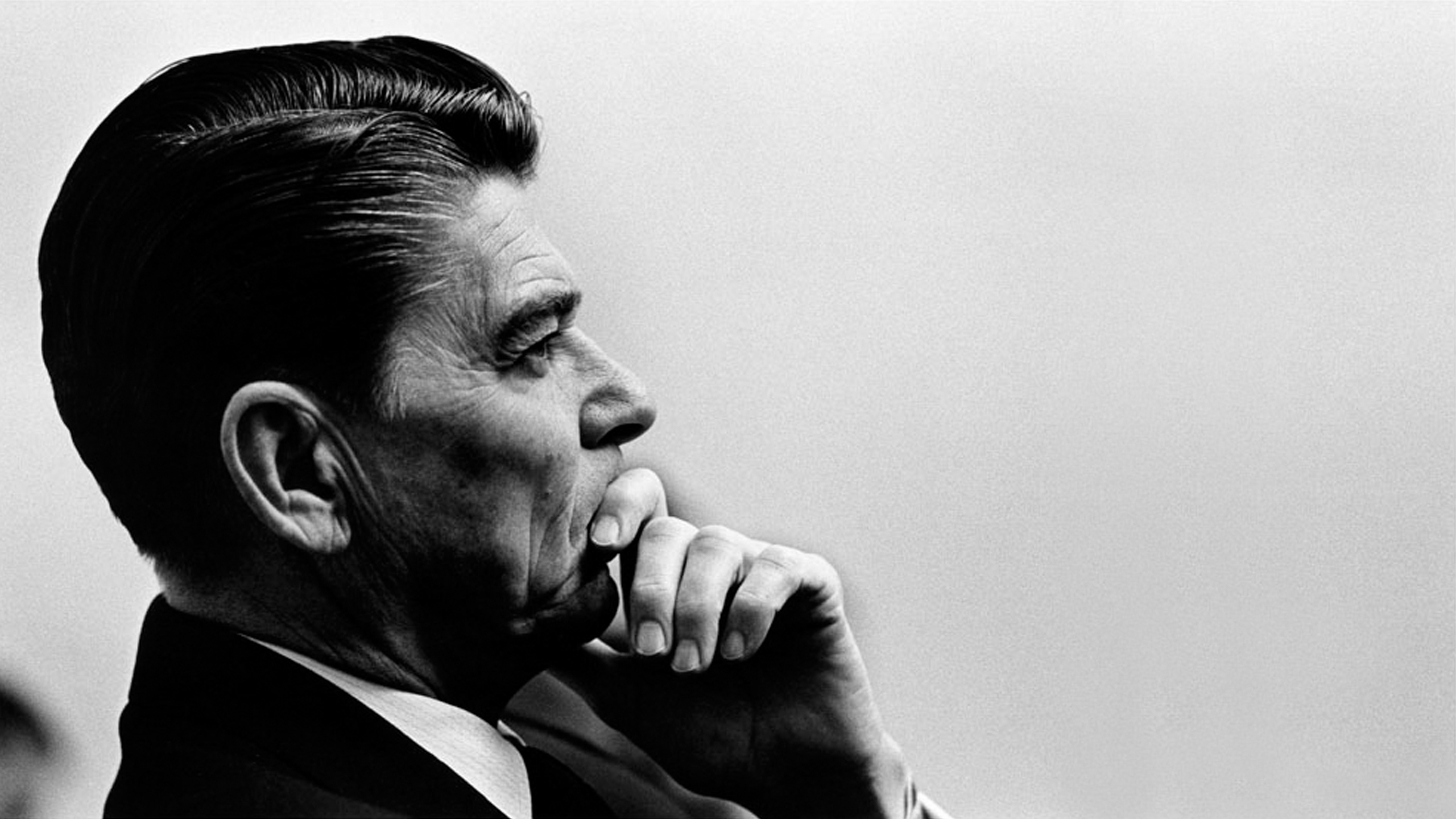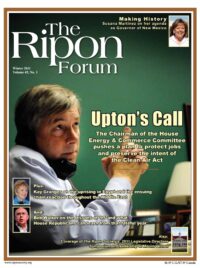
“Well, 49 states, 59% of the vote, and 525 electoral votes.”
President Ronald Reagan wrote with satisfaction in his diary as he summarized his landslide reelection in November 1984. Reagan’s triumph, however, hardly seemed possible just two years earlier. In the 1982 mid-term elections, Republicans added one seat to their majority in the U.S. Senate, but lost 26 seats in the House of Representatives where the Democrats already had a 50 seat advantage.
Presidential approval polls also registered new lows for Reagan. The reason for widespread discontent was obvious: the economy was experiencing what was then the worst recession since the 1930s. At the end of 1982, unemployment peaked at 10.8 percent. Many Americans blamed Reaganomics – the president’s then-unconventional program of tax cuts, discretionary spending reductions, and defense increases – for the nation’s economic distress. Some political observers predicted that Reagan would be a one-term president.
Reagan, however, was confident that his economic program would work. Optimism was one of his most appealing qualities and most important political assets. So, too, was pragmatism — willingness to compromise when political realities prevented him from achieving everything he desired. At a time when nothing could pass the House of Representatives over the opposition of Democratic Speaker Tip O’Neill, Reagan used his pragmatic skill to make compromises that strengthened his political position. By the beginning of 1984, Reagan looked practically unbeatable.
Meeting domestic challenges
Improvements in the economy contributed to Reagan’s increasing political strength in 1983. The economy began expanding in late 1982, growing by over 7 percent in 1983, while unemployment declined to 8.1 percent by year’s end. Inflation, which had soared to a painful 13.5 percent just before Reagan took office, plunged to only 3.2 percent in 1983 — the lowest level since 1967. Federal deficits, however, set what were then new records, despite Reagan’s promise to balance the budget. But the President said he gave higher priority to tax cuts and increased military strength and thought that a majority of Americans agreed.
At a time when nothing could pass the House of Representatives over the opposition of … Tip O’Neill, Reagan used his pragmatic skill to make compromises that strengthened his political position.
During 1983, Reagan bargained with O’Neill to advance his agenda. Particularly notable was a compromise on Social Security. Reagan had established a commission headed by economist Alan Greenspan to recommend reforms. The White House kept close watch on the commission’s work. Reagan at times met with Greenspan, while Chief of Staff James Baker negotiated with commission members on a set of recommendations – including higher payroll taxes, a gradual increase in the retirement age, and a postponement of cost-of-living increases for current retirees –that both the President and the Speaker could support. Reagan signed these reforms into law in April 1983. They ensured the solvency of the Social Security system. In addition, the legislation deprived Democrats of an issue they had used in the 1982 elections – that Reagan would weaken or even destroy Social Security.
Reagan also made a concession when he went along with a hike in the federal gas tax to finance highway construction jobs to help bring down unemployment. But this tactical retreat helped preserve an important reform. He was able to fend off attempts to eliminate or delay the final installment of the 25 percent cut in individual income taxes that Congress had approved in 1981. For Reagan, that was the victory that really mattered.
Preparing for foreign threats
In foreign affairs, Reagan made adjustments that overcame public anxieties about his pursuit of peace. The year 1983 was one of the tensest of the Cold War. An ardent anti-Communist, Reagan bluntly criticized Soviet practices and policies. In March of that year, he denounced the Soviet Union as an “evil empire.” Critics complained that Reagan was more interested in scoring rhetorical points than in the hard bargaining that could advance arms control or human rights. Two weeks later, he proposed a Strategic Defense Initiative (SDI) that could shield Americans from nuclear attack. Reagan genuinely abhorred nuclear weapons; the President’s detractors, however, dismissed SDI as a technological fantasy – Star Wars – that would escalate the arms race. In September, U.S.-Soviet relations deteriorated further when the Soviets shot down a Korean Airlines passenger plane that had strayed into their airspace. Reagan condemned the Soviet action and the resulting deaths of the 269 people on board as “an act of barbarism.” By November, suspicion and distrust were so pervasive that when U.S. forces participated in a NATO military exercise, some Soviet leaders feared an actual invasion.
An ardent anti-Communist, Reagan bluntly criticized Soviet practices and policies. In March of that year, he denounced the Soviet Union as an “evil empire.”
Many Americans were also worried about the possibility of war. Reagan’s build-up of U.S. armed forces contributed to the popularity of the nuclear freeze movement — a grassroots campaign to persuade both the United States and Soviet Union to halt the production and testing of nuclear weapons. Reagan opposed a nuclear freeze, charging it would lock in Soviet advantages. The freeze movement sponsored rallies and petition drives across the nation. In May 1983, the House of Representatives passed a freeze resolution. In November, almost 100 million viewers watched a made-for-television movie, The Day After, which portrayed life after a nuclear exchange. The program “greatly depressed” Reagan, but he also resolved to do all he could so that “there is never a nuclear war.”
The fears and controversies of 1983 strengthened Reagan’s desire to lower Cold War tensions. Reagan wrote, “I began to realize that many Soviet officials feared us . . . as potential aggressors who might hurl nuclear weapons at them in a first strike.” As early as February 1983, Reagan had quietly met with Soviet Ambassador Anatoly Dobrynin to discuss how to make progress on matters of common concern. After learning about the Soviet fears of a U.S. attack, Reagan decided on a dramatic, public gesture.
The things “that make life worth living”
In early 1984, Reagan gave a speech about Soviet-American relations and “the cause of peace.” He emphasized that while both sides had major differences, “we should always remember that we do have common interests and the foremost among them is to avoid war and reduce the level of arms.” As he often did, Reagan found a memorable way to explain his thinking. He imagined Soviet citizens Ivan and Anya spending time with Americans Jim and Sally with no language barrier to keep them from developing a friendship. “Would they debate the differences between their respective governments?” Reagan asked. “Or would they find themselves comparing notes about their children and what each other did for a living?”
By the beginning of 1984, Reagan’s approval rating was at 53 percent, an increase of 14 percent since the start of 1983.
The Great Communicator brilliantly made his point. “People want to raise their children in a world without fear and without war. They want to have some of the good things . . . that make life worth living.” Reagan promised to work with Soviet leaders “to fulfill the hopes and dreams of those we represent and, indeed, of people everywhere.”
The speech was another triumph in what had been a pivotal year. By the beginning of 1984, Reagan’s approval rating was at 53 percent, an increase of 14 percent since the start of 1983. By helping to restore prosperity, standing for what he believed, using his pragmatic political skills to compromise when necessary, and explaining his achievements and hopes to the American people, Reagan moved into position to win a second term.
When he proclaimed during his reelection campaign that it was “Morning in America,” an overwhelming majority of voters agreed.
 Chester Pach is a member of the History Department at Ohio University. His book, The Presidency of Ronald Reagan, will soon be published by the University Press of Kansas.
Chester Pach is a member of the History Department at Ohio University. His book, The Presidency of Ronald Reagan, will soon be published by the University Press of Kansas.




